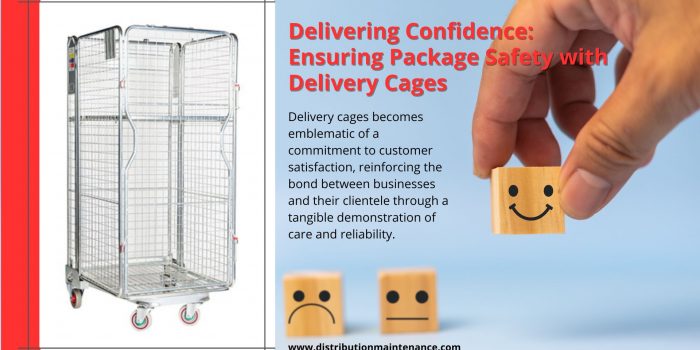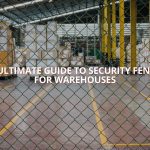Delivering Confidence: Ensuring Package Safety with Delivery Cages
Impact of Package Safety on Customer Satisfaction
1. Linking Package Security to Customer Trust:
In the world of e-commerce and online shopping, customer trust is paramount. When customers make a purchase, especially in the case of high-value or sensitive items, they are entrusting the retailer or logistics provider with the safe and secure delivery of their package. The security of the package during transit becomes a direct reflection of the reliability and professionalism of the service. This trust is fortified by the meticulous use of robust delivery cages, ensuring that each parcel is not just a product in transit but a commitment to the secure and reliable conveyance of goods. The use of these delivery cages becomes emblematic of a commitment to customer satisfaction, reinforcing the bond between businesses and their clientele through a tangible demonstration of care and reliability.
Building a Sense of Reliability: Consistently delivering packages in secure and intact condition builds a sense of reliability. Customers are more likely to choose and recommend a service that consistently meets or exceeds their expectations in terms of package security.
Impact on Brand Perception: The condition in which a package arrives speaks volumes about the brand. A damaged or tampered package can create a negative impression, potentially eroding the trust that customers place in the brand. On the other hand, secure deliveries reinforce the idea that the brand is committed to providing a reliable and trustworthy service.
Positive Word-of-Mouth Marketing: Satisfied customers are likely to share their positive experiences with friends and family. Word-of-mouth marketing plays a significant role in the success of businesses, and safe deliveries contribute directly to positive word-of-mouth, helping to attract new customers and retain existing ones.
Repeat Business and Customer Loyalty: Customers who consistently receive packages in perfect condition are more likely to become repeat customers. This loyalty is not just based on the quality of the product but extends to the overall delivery experience, including the security of the package.
2. How Safe Deliveries Enhance the Customer Experience:
Ensuring the safety of packages during the delivery process goes beyond just meeting a basic expectation; it contributes significantly to the overall customer experience.
Reducing Stress and Uncertainty: Customers often experience a level of stress and uncertainty until their package safely arrives. Safe deliveries alleviate this stress, providing customers with peace of mind and a positive emotional connection to the entire shopping experience.
Timely and Intact Deliveries: Customers value not only timely deliveries but also the condition in which their packages arrive. Safe deliveries contribute to a seamless and positive customer experience by meeting both these crucial criteria.
Building a Positive Perception of the Brand: Each successful, secure delivery adds to the overall positive perception of the brand. Customers associate the brand with reliability, professionalism, and a commitment to customer satisfaction when their packages consistently arrive in optimal condition.
Enhancing Customer Satisfaction: A safe and secure delivery is a fundamental aspect of customer satisfaction. It goes beyond the product itself and contributes to the overall satisfaction with the entire purchasing process, from the online order to the physical receipt of the package.
Features of Secure Delivery Cages
Reinforced Construction for Package Protection:
Ensuring the structural integrity and robustness of delivery cages is a foundational element in safeguarding packages during transit. The construction of these cages plays a pivotal role in withstanding the rigours of the supply chain and protecting contents from potential damage. Key aspects of reinforced construction include:
Durable Materials: Utilising high-quality and durable materials, such as industrial-grade steel or aluminium, forms the basis of a secure delivery cage. These materials are chosen for their strength, resistance to wear and tear, and the ability to endure various environmental conditions.
Impact Resistance: The reinforced construction should incorporate features that enhance impact resistance. This is especially crucial during loading, unloading, and transit, where packages may be subjected to sudden movements or collisions. Protective elements like reinforced corners and impact-absorbing components contribute to minimising the risk of damage.
Sturdy Framework: The overall framework of the delivery cage should be sturdy and well-designed to withstand the weight of stacked packages. A robust framework not only ensures the structural integrity of the cage but also prevents the risk of collapsing or bending under the pressure of heavy loads.
Weather-Resistant Finishes: To protect packages from the elements, delivery cages may feature weather-resistant finishes or coatings. This guards against corrosion, rust, and other environmental factors that could compromise the security of the packages.
Locking Mechanisms and Tamper-Proof Design:
The security of delivery cages is significantly heightened through the incorporation of advanced locking mechanisms and tamper-proof designs. These features not only deter unauthorised access but also instil confidence in both businesses and customers regarding the safety of shipped items.
Secure Locking Systems: Delivery cages may employ various locking systems, ranging from traditional padlocks to more advanced digital or biometric options. The choice of locking system often depends on the level of security required and the specific needs of the shipping process.
Tamper-Evident Seals: Tamper-evident features are crucial in providing visual indicators of any unauthorised access or tampering. Seals or indicators are designed to break or change in appearance if the cage has been opened, immediately signalling that the package may have been compromised.
Integrated Alarms and Sensors: Some advanced delivery cages may incorporate integrated alarms or sensors that trigger alerts in case of tampering. This proactive approach not only deters theft but also enables swift responses to any security breaches, minimising potential damage or loss.
Customizable Security Levels: Recognizing that different shipments may require varying levels of security, modern delivery cages often come with customizable security options. This flexibility allows businesses to tailor the security features based on the nature and value of the packages being transported.
1. Cushioning and Padding Strategies:
Protecting packages from the bumps, vibrations, and shocks encountered during transit is a critical aspect of ensuring they arrive in pristine condition. Employing effective cushioning and padding strategies within delivery cages can significantly reduce the risk of damage. Here are some key considerations:
Bubble Wrap and Foam Inserts: Wrapping fragile items with bubble wrap or securing them in foam inserts provides a protective barrier against impact. These materials absorb shocks and vibrations, preventing direct contact between the package and the cage.
Inflatable Air Cushions: Inflatable air cushions strategically placed within the delivery cage create a cushioning layer around the packages. These cushions act as a shock absorber, minimising the effects of sudden movements or jolts during transit.
Customised Packaging Materials: Tailoring packaging materials to the specific needs of the items being shipped is essential. Using custom-fit boxes and cushioning materials designed to surround and support the contours of the product adds an extra layer of protection.
Void Fill Materials: Filling any empty spaces within the delivery cage with void fill materials, such as packing peanuts or air pillows, prevents items from shifting during transit. This reduces the risk of breakage or damage caused by items colliding with each other.
Anti-Static Packaging: For sensitive electronic components, anti-static packaging materials can prevent electrostatic discharge, safeguarding delicate items from potential damage during transportation.
2. Best Practices for Stacking and Loading:
Proper stacking and loading techniques are instrumental in preventing damage to packages and ensuring the overall stability of the cargo within delivery cages. Implementing best practices in this regard involves careful planning and attention to detail:
Weight Distribution: Distributing weight evenly across the delivery cage is crucial. Placing heavier items at the bottom and lighter, more fragile items on top helps maintain balance and reduces the risk of crushing or breakage.
Securing Items with Straps or Bands: Using straps or bands to secure items within the delivery cage prevents them from shifting during transit. This is particularly important for items of irregular shapes or those prone to movement.
Labelling Fragile Items: Clearly marking fragile items and ensuring that they are placed in a way that minimises the risk of compression or impact is a simple yet effective practice. This alerts handlers to exercise extra caution during loading and unloading.
Utilising Load Distribution Techniques: Applying load distribution techniques, such as creating layers of items with heavier ones at the bottom and lighter ones on top, helps maintain stability. This reduces the likelihood of packages shifting and colliding during transit.
Training and Guidelines for Handlers: Providing training to personnel involved in the loading and unloading process is essential. Clear guidelines on proper stacking techniques, weight limits, and handling procedures contribute to a consistent and standardised approach.
By combining effective cushioning and padding strategies with best practices for stacking and loading, businesses can significantly reduce the incidence of damage during transit. These proactive measures not only enhance the protection of shipped items but also contribute to a positive customer experience by ensuring the safe arrival of goods.
Optimising Internal Layout for Package Stability
Adjustable Compartments for Different Sized Packages:
The internal layout of delivery cages plays a crucial role in maintaining package stability and preventing damage during transit. One key strategy is the incorporation of adjustable compartments to accommodate a variety of package sizes. This approach offers several benefits:
Versatility and Flexibility: Adjustable compartments provide a versatile solution for transporting packages of varying shapes and sizes. This flexibility is especially important in logistics, where the diversity of goods being shipped can range from small, delicate items to larger, bulkier products.
Customizable Configurations: The ability to customise the internal layout allows for the creation of tailored configurations based on the specific dimensions of the packages being transported. This ensures a snug fit for each item, minimising the risk of movement and potential damage.
Optimal Space Utilisation: Adjustable compartments maximise the use of available space within the delivery cage. By efficiently utilising the interior dimensions, businesses can enhance their shipping efficiency, reduce the number of required trips, and ultimately lower transportation costs.
Streamlined Sorting and Unloading: Configurable compartments simplify the sorting and unloading processes at distribution centres. With packages neatly organised in designated spaces, handlers can quickly identify, access, and unload items, reducing the handling time and minimising the risk of mishandling.
Adaptability to Changing Inventories: Businesses that deal with dynamic inventories benefit from the adaptability provided by adjustable compartments. As product offerings evolve, the internal layout can be easily modified to accommodate new items without compromising package stability.
2. Securing Fragile Items During Transit:
Fragile items require special attention and care to ensure they reach their destination intact. The internal layout of delivery cages can be optimised to provide enhanced protection for delicate or breakable items:
Cushioning and Padding Zones: Designating specific zones within the delivery cage for fragile items allows for targeted cushioning and padding. These areas can be lined with shock-absorbing materials, such as foam or bubble wrap, to provide an extra layer of protection against impacts.
Separate Compartments for Fragile Items: Creating separate compartments or sections specifically designed for fragile items prevents them from coming into direct contact with heavier or more robust packages. This segregation minimises the risk of breakage due to compression or collisions.
Clear Labelling and Handling Instructions: Proper communication is key to ensuring the safe transit of fragile items. Clear labelling, along with handling instructions indicating the delicate nature of the contents, informs handlers to exercise extra care during loading, unloading, and transportation.
Strategic Placement within the Cage: Placing fragile items strategically within the delivery cage is essential. Items should be positioned to avoid direct contact with the walls of the cage or other potentially impact-prone surfaces. This careful arrangement minimises the risk of breakage during transit.
Testing and Validation of Packaging Solutions: Before deployment, businesses can conduct testing and validation processes to assess the effectiveness of the chosen packaging solutions for fragile items. This proactive approach helps identify and address potential vulnerabilities in the shipping process.
The blog underscored the impact of package safety on customer satisfaction, elucidating how the reliability of deliveries directly correlates with customer trust. A secure delivery, coupled with a positive unboxing experience, contributes not only to customer loyalty but also to positive word-of-mouth marketing that can elevate a brand’s reputation.
Moreover, we explored how businesses can navigate regulatory landscapes, aligning with industry guidelines and international shipping standards. This commitment to compliance not only safeguards packages but also establishes a foundation of trust with global partners and customers alike.
In conclusion, the blog emphasised that ensuring package safety is not merely a logistical consideration; it is a commitment to delivering confidence. By investing in robust delivery cages, embracing best practices for package protection, and aligning with industry standards, businesses can forge a path toward a shipping process that instil trust, enhances customer satisfaction, and solidifies their position in the competitive world of modern commerce. As the journey of packages continues to evolve, the commitment to delivering confidence remains steadfast, ensuring that each parcel arrives not just at its destination but in the hands of a satisfied and confident recipient.









